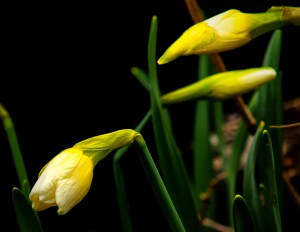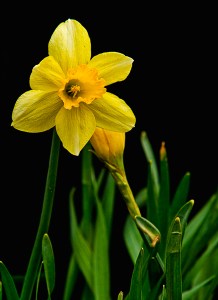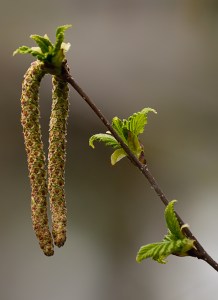Finally…finally the spring warmth has crept in and we are getting the rain, sun, rain kind of days that are usual this time of year.
I think the plants in my garden that were holding back because of the cold days and nights last week will be exploding in bloom in no time. I knew I would miss the beginning growth if I hesitated.
I sent a text to my friend Jo inviting her to join me and she showed up a few hours later ready to photograph the garden with me.
In my article last week I wrote, “why not photograph the flowers just as one would do a portrait.” So for our photos I got out two small 2’x2’ backdrops that Jo and I could place behind some of the flowers. Remember that I wrote that I used a small backdrop for flowers and other small items that is made of black velvet material attached to sharpened dowels that easily poke into the ground.
This time I mounted one wireless flash on a light stand, but decided not to use an umbrella. We took turns moving the flash for each other.
Jo shot with my 70-180mm AF macro and I used my 200mm Manual macro.
I also used the uniquely flexible Benbo tripod I wrote about last week. There was a slight intermittent breeze that was possible for Jo to overcome with her AF lens, but my manual lens had to have support, so the tripod was a must for me.
We were fortunate that the day was overcast. That made it easy to use a wide aperture to soften the background while still being able to underexpose the ambient light.
As I wrote last week, “The exposure was made exactly the same way I would have made it if photographing a person in an outdoor studio. Slightly underexpose the ambient light, position the flash for the best light direction, and continue to make tests until I got lighting that would flatter my subject.”
We wandered the garden looking for those flowers and plants that are early blooming and those that are just showing buds at the end of their branches.
For me, photographing my garden is a time consuming process that includes a tripod, an off-camera flash, a backdrop and a lot of walking around to find the right shape in the right location.
I met a biologist that decided to take up photography. He mostly used natural light and occasionally one of those inexpensive constant light kits. He would cut the plant that he wanted to photograph and use a clamp to position it. For me the process of photographing a flower usually includes its life cycle from the cool days of early spring to snowy winter days. So plant clippers, clamps and lights that plug into an electric outlet don’t work for me at all. I photographed the garden a few days ago. There has been rain and warm sun since then and I think it’ll rain again tomorrow. That mean I can expect may garden to have gone through a transition and photographing it will be a new experience. Spring, summer, fall and winter. It always is.
I will admit that I am not a gardener. I rarely remove weeds unless the get in the way of something I am doing. I don’t go through plant catalogues in the spring and can’t begin to name the plants that grow in my garden. But I do like to photograph those things that grow or just reside in my yard. My wife used to complain that I enjoyed the photography more than her garden. I disagreed. I like the garden because I like to photograph it.
Photographing the garden is calming and can be creative for those that take the time. That said here is a quote by Canadian photographer Freeman Patterson that I have used before.
In his book, “Photography and the Art of Seeing” he wrote, “ Seeing, in the finest and broadest sense, means using your senses, you intellect, and your emotions. It means encountering your subject matter with your whole being. It means looking beyond the labels of things and discovering the remarkable world around you.”







I love your post and quotes…during this time, there’s nothing more calming and rewarding than photographing our own gardens.
LikeLike
Lovely pictures of your garden, I don’t have flowers at the moment so am waiting for the buddlea to come forth and give me butterflies!
LikeLike